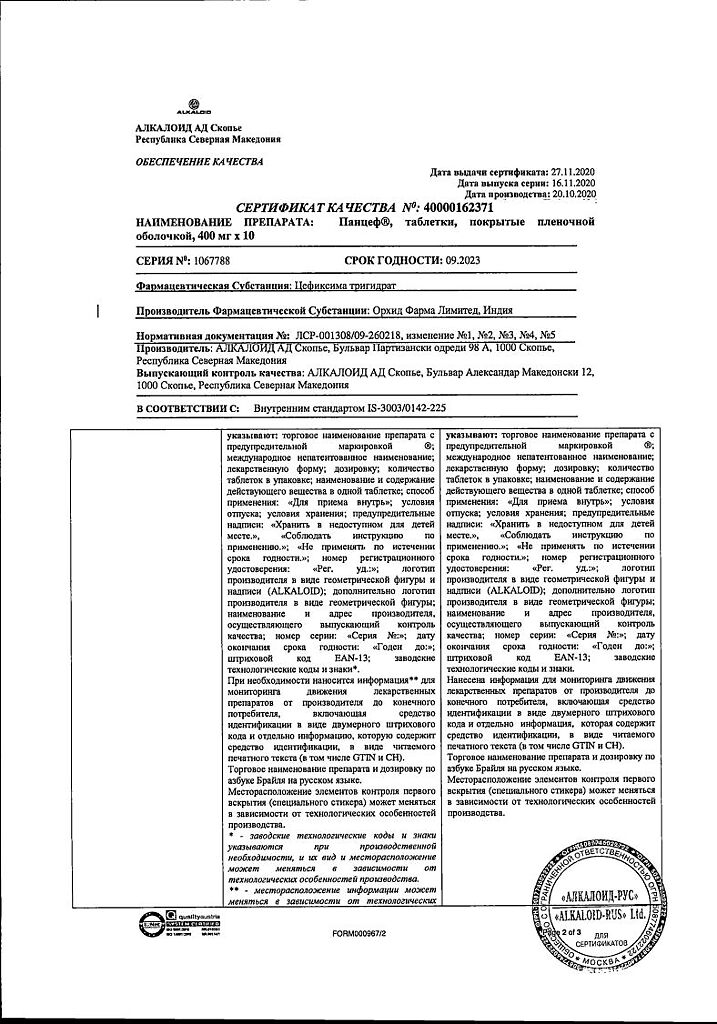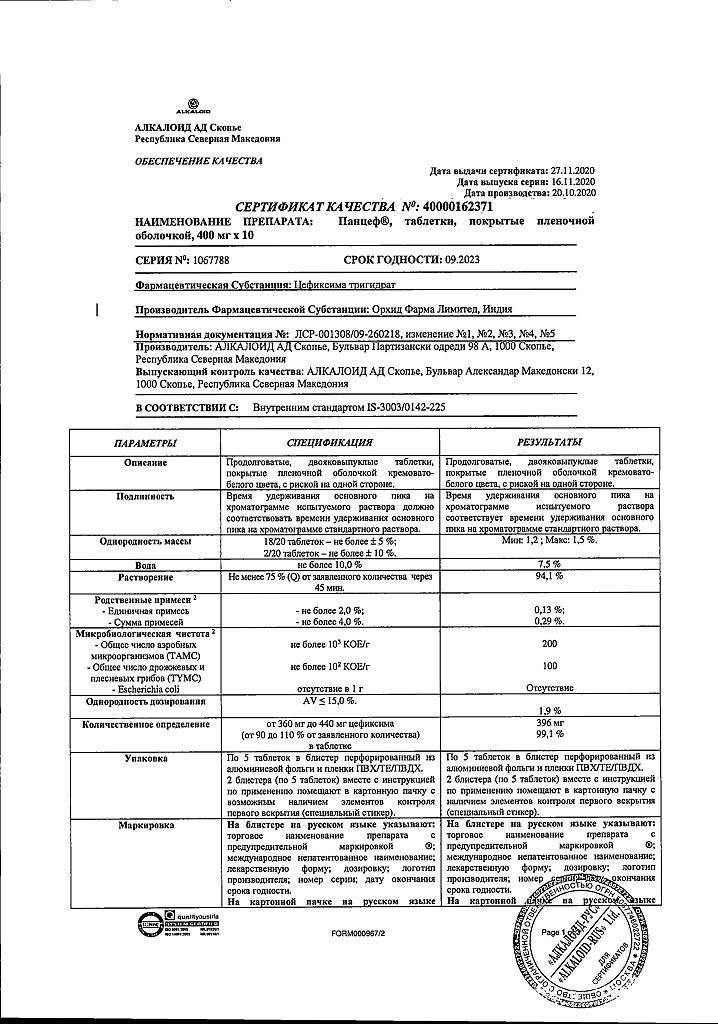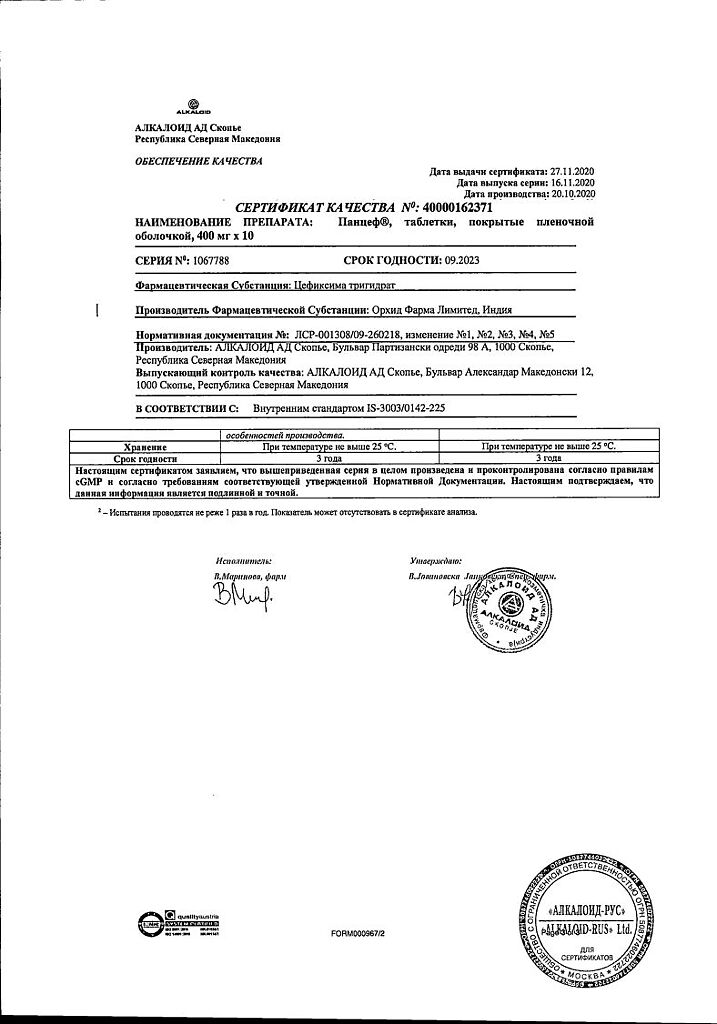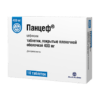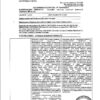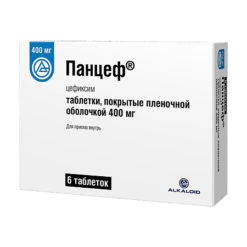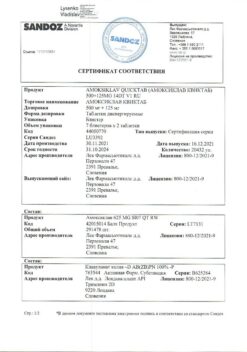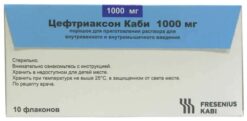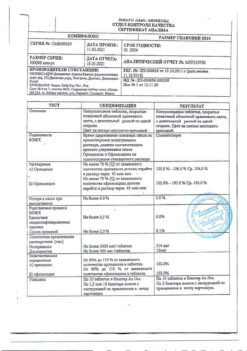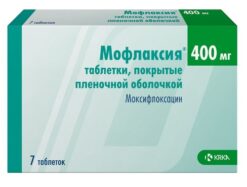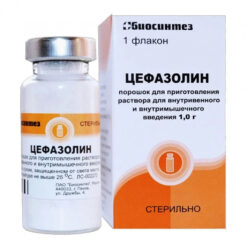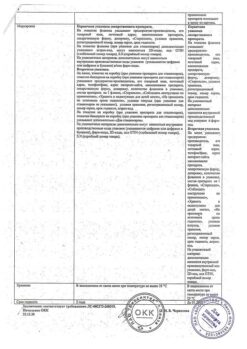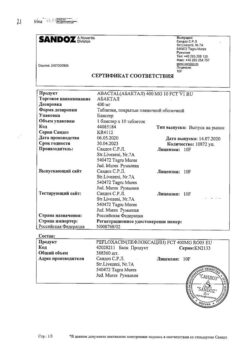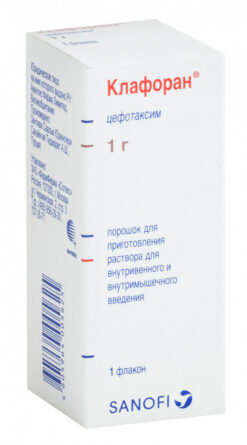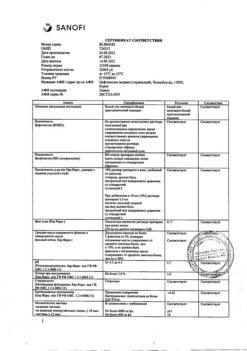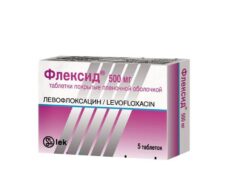No products in the cart.
Pancef, 400 mg 10 pcs
€33528.00 €27.94
Description
Pharmacological action – broad spectrum antibacterial (bactericidal).
Pharmacodynamics
Cefixime is a cephalosporin antibiotic of III generation for oral administration with strong antibacterial activity against most gram-positive and gram-negative microorganisms.
The mechanism of action is caused by inhibition of the synthesis of the cell membrane of the pathogen. It is resistant to beta-lactamases of both Gram-positive and Gram-negative microorganisms.
Highly active against Streptococcus pneumoniae, Streptococcus pyogenes, Streptococcus agalactiae, Haemophilus influenzae, Haemophilus parainfluenzae, Moraxella catarrhalis (including strains producing beta-lactamases). beta-lactamase-producing strains), Escherichia coli, Proteus mirabilis, Proteus vulgaris, Neisseria gonorrhoeae, Klebsiella pneumoniae, Klebsiella oxytoca, Pasteurella multocida, Providencia spp, Salmonella spp., Shigella spp., Citrobacter spp. (including Citrobacter diversus), Serratia marcescens.
Pseudomonas spp., Acinetobacter spp., some strains of Streptococcus, Enterococcus spp. (methicillin-resistant strains), Listeria monocytogenes, Bacteroides fragilis, most strains of Staphylococcus, Enterobacter and Clostridium are resistant to cefixime.
Pharmacokinetics
Intake. After oral administration, absorption of cefixime is 40-50% regardless of meals; however, it has been noted that Cmax in blood serum is reached faster by 0.8 h when the drug is taken with food. When taking the drug in tablet form at a dose of 400 mg, Cmax in plasma is 3.5 mcg/ml. Tmax is 2-6 hours.
After taking the suspension, Cmax (compared to tablets) is 25-50% higher. Tmax is 2-6 h for 400 mg/5 ml suspension and 2-5 h for 200 mg/5 ml suspension. Tmax in plasma is also 2-6 hours.
Distribution. Binding to plasma proteins is 50-60%. Vd is 0.6-1.1 l/kg. High concentrations of the drug remain in blood serum, bile and urine for a long time.
Metabolism. There are no data on cefixime metabolites.
Elimation. Cefixime is excreted mainly by the kidneys by glomerular filtration in unchanged form – 50%, with bile – 10%.
The T1/2 in healthy volunteers is on average 3 to 4 h, in some cases up to 9 h. Long T1/2 makes possible single dosing.
In patients with impaired renal function in creatinine Cl 20-40 ml/min T1/2 is increased and on average 6.4 h, in creatinine Cl 5-20 ml/min T1/2 is 11.5 h.
Indications
Indications
Infectious and inflammatory diseases caused by microorganisms sensitive to cefixime:
upper respiratory tract infections (tonsillitis, pharyngitis, sinusitis);
otitis media;
lower respiratory tract infections (bronchitis, tracheobronchitis);
urinary tract infections;
uncomplicated gonorrhea (urethra and cervix).
Pharmacological effect
Pharmacological effect
Pharmacological action – broad spectrum antibacterial (bactericidal).
Pharmacodynamics
Cefixime is a third-generation cephalosporin antibiotic for oral administration with pronounced antibacterial activity against most gram-positive and gram-negative microorganisms.
The mechanism of action is due to inhibition of the synthesis of the pathogen’s cell membrane. Resistant to beta-lactamases of both gram-positive and gram-negative microorganisms.
Highly active against Streptococcus pneumoniae, Streptococcus pyogenes, Streptococcus agalactiae, Haemophilus influenzae, Haemophilus parainfluenzae, Moraxella catarrhalis (including strains producing beta-lactamases), Escherichia coli, Proteus mirabilis, Proteus vulgaris, Neisseria gonorrhoeae, Klebsiella pneumoniae, Klebsiella oxytoca, Pasteurella multocida, Providencia spp., Salmonella spp., Shigella spp., Citrobacter spp. (including Citrobacter diversus), Serratia marcescens.
Pseudomonas spp., Acinetobacter spp, some strains of Streptococcus, Enterococcus spp. (methicillin-resistant strains), Listeria monocytogenes, Bacteroides fragilis, most strains of Staphylococcus, Enterobacter and Clostridium are resistant to cefixime.
Pharmacokinetics
Suction. After oral administration, the absorption of cefixime is 40–50%, regardless of food intake; however, it was noted that Cmax in the blood serum is achieved faster by 0.8 hours when taking the drug with food. When taking the drug in tablet form at a dose of 400 mg, Cmax in plasma is 3.5 mcg/ml. Tmax – 2–6 hours.
After taking the suspension, Cmax (compared to tablets) is 25–50% higher. Tmax – 2–6 hours for a suspension of 400 mg/5 ml and 2–5 hours for a suspension of 200 mg/5 ml. Tmax in blood plasma is also 2–6 hours.
Distribution. Plasma protein binding is 50–60%. Vd is 0.6–1.1 l/kg. High concentrations of the drug remain for a long time in blood serum, bile, and urine.
Metabolism. There is no data on the metabolites of cefixime.
Excretion. Cefixime is excreted mainly by the kidneys by glomerular filtration in unchanged form – 50%, with bile – 10%.
T1/2 in healthy volunteers averages 3–4 hours, in some cases up to 9 hours. Long T1/2 makes single dosing possible.
If renal function is impaired, with a creatinine Cl of 20–40 ml/min, T1/2 increases and averages 6.4 hours; with a creatinine Cl of 5–20 ml/min, T1/2 is 11.5 hours.
Special instructions
Special instructions
Patients with a history of allergic reactions to penicillins may have increased sensitivity to cephalosporin antibiotics. If an allergic reaction occurs, you must stop using the drug and, if necessary, take appropriate measures.
As with the use of other antibacterial drugs, long-term use of cefixime may disrupt the normal intestinal microflora, which can lead to the growth of Clostridium difficile, causing severe diarrhea and pseudomembranous colitis.
During treatment, a false-positive direct Coombs reaction and a false-positive urine reaction to glucose and ketonuria are possible.
Active ingredient
Active ingredient
Cefixime
Composition
Composition
1 film-coated tablet contains:
Active ingredient:
cefixime (in the form of cefixime trihydrate) – 400–447.630 mg;
Excipients: MCC; pregelatinized starch; calcium dihydrogen phosphate; gelatin; corn starch; sodium lauryl sulfate; magnesium stearate; hypromellose; macrogol 4000; titanium dioxide (E171).
Pregnancy
Pregnancy
The use of cefixime during pregnancy and lactation is possible only if the expected benefit to the mother outweighs the potential risk to the fetus. If it is necessary to prescribe during lactation, breastfeeding should be stopped.
Contraindications
Contraindications
hypersensitivity to cephalosporins, penicillins, penicillamine;
children up to 6 months (for suspension) and up to 12 years (for tablets).
With caution: old age, renal failure, colitis (history).
Side Effects
Side Effects
Allergic reactions: urticaria, skin flushing, skin itching, itching in the genital area, eosinophilia, fever, exudative erythema multiforme (including Stevens-Johnson syndrome), toxic epidermal necrolysis (Lyell’s syndrome).
From the nervous system: headache, dizziness, tinnitus.
From the genitourinary system: vaginitis.
From the urinary system: interstitial nephritis.
From the digestive system: nausea, vomiting, stomatitis, diarrhea, abdominal pain, constipation, pseudomembranous enterocolitis, dysbacteriosis, cholestasis; cholestatic jaundice.
From the hematopoietic organs: pancytopenia, leukopenia, neutropenia, agranulocytosis, thrombocytopenia, aplastic anemia, hemolytic anemia, bleeding.
Laboratory indicators: increased activity of liver transaminases and alkaline phosphatase, hyperbilirubinemia, increased urea nitrogen, hypercreatininemia, increased PT.
Other: candidiasis, development of hypovitaminosis B, shortness of breath.
Interaction
Interaction
Blockers of tubular secretion (allopurinol, diuretics, etc.) delay the excretion of cefixime by the kidneys, which can lead to increased toxicity.
Cefixime reduces the prothrombin index and enhances the effect of indirect anticoagulants.
Antacids containing magnesium or aluminum hydroxide slow down the absorption of the drug. With the simultaneous use of cefixime and carbamazepine, the concentration of the latter increases.
Overdose
Overdose
Symptoms: increased manifestations of the described side effects.
Treatment: gastric lavage, symptomatic and supportive therapy.
Hemodialysis and peritoneal dialysis are ineffective.
Storage conditions
Storage conditions
In a place protected from light, at a temperature of 15–25 °C
Shelf life
Shelf life
3 years
Manufacturer
Manufacturer
Alkaloid AD Skopje, Republic of North Macedonia
Additional information
| Shelf life | 3 years |
|---|---|
| Conditions of storage | In a light-protected place at 15-25 °C |
| Manufacturer | Alkaloid AD Skopje, Republic of Northern Macedonia |
| Medication form | pills |
| Brand | Alkaloid AD Skopje |
Other forms…
Related products
Buy Pancef, 400 mg 10 pcs with delivery to USA, UK, Europe and over 120 other countries.


